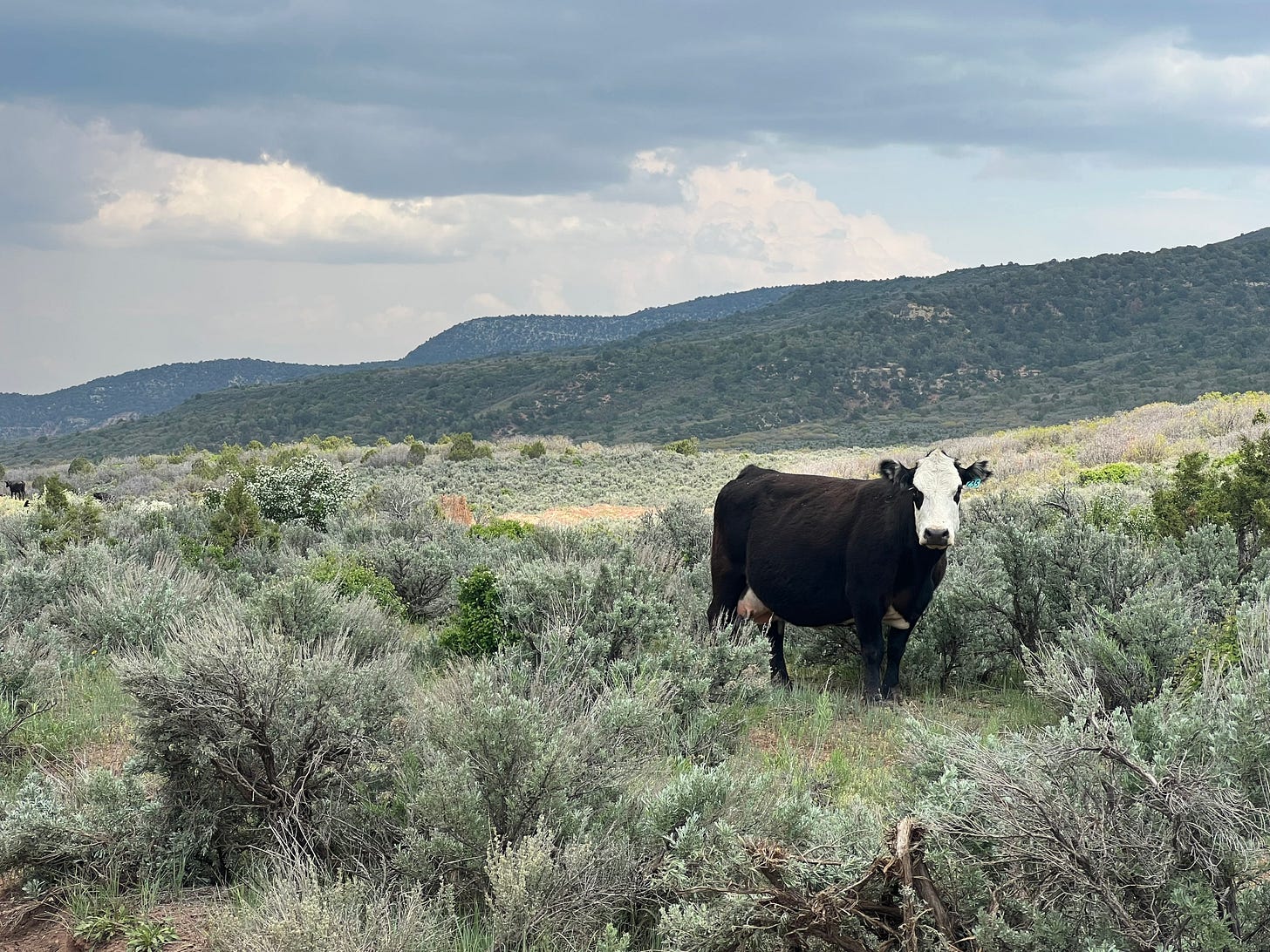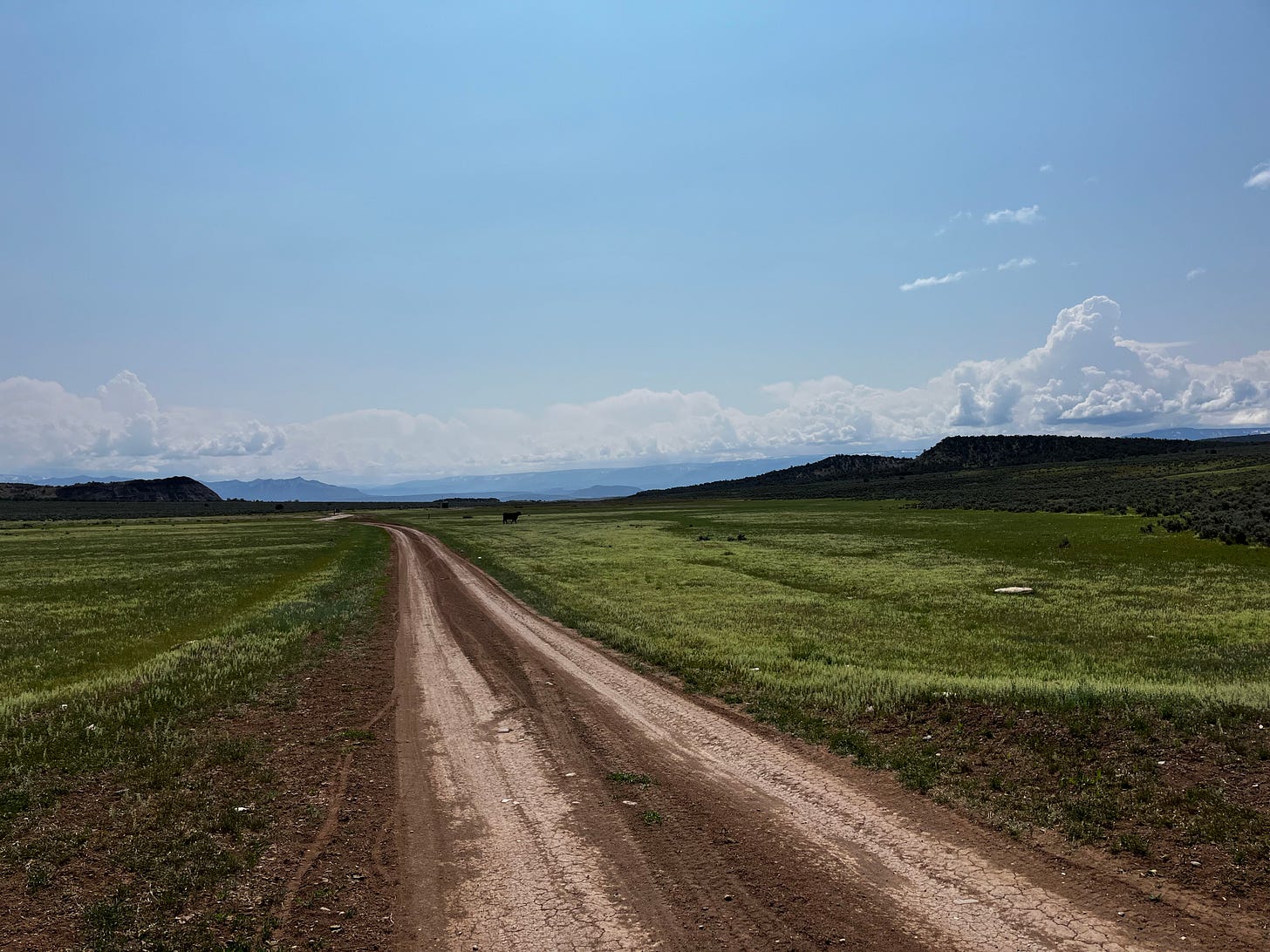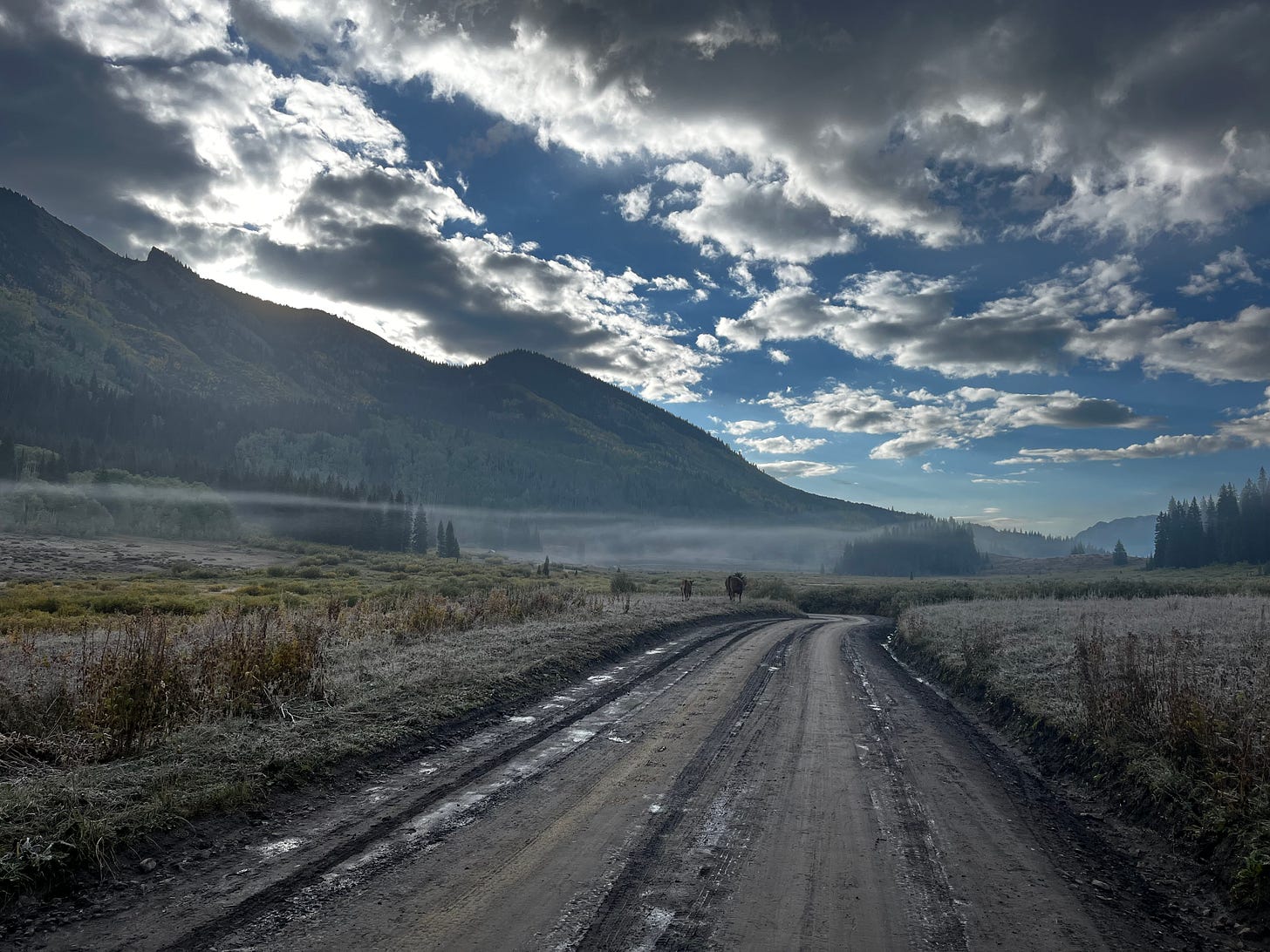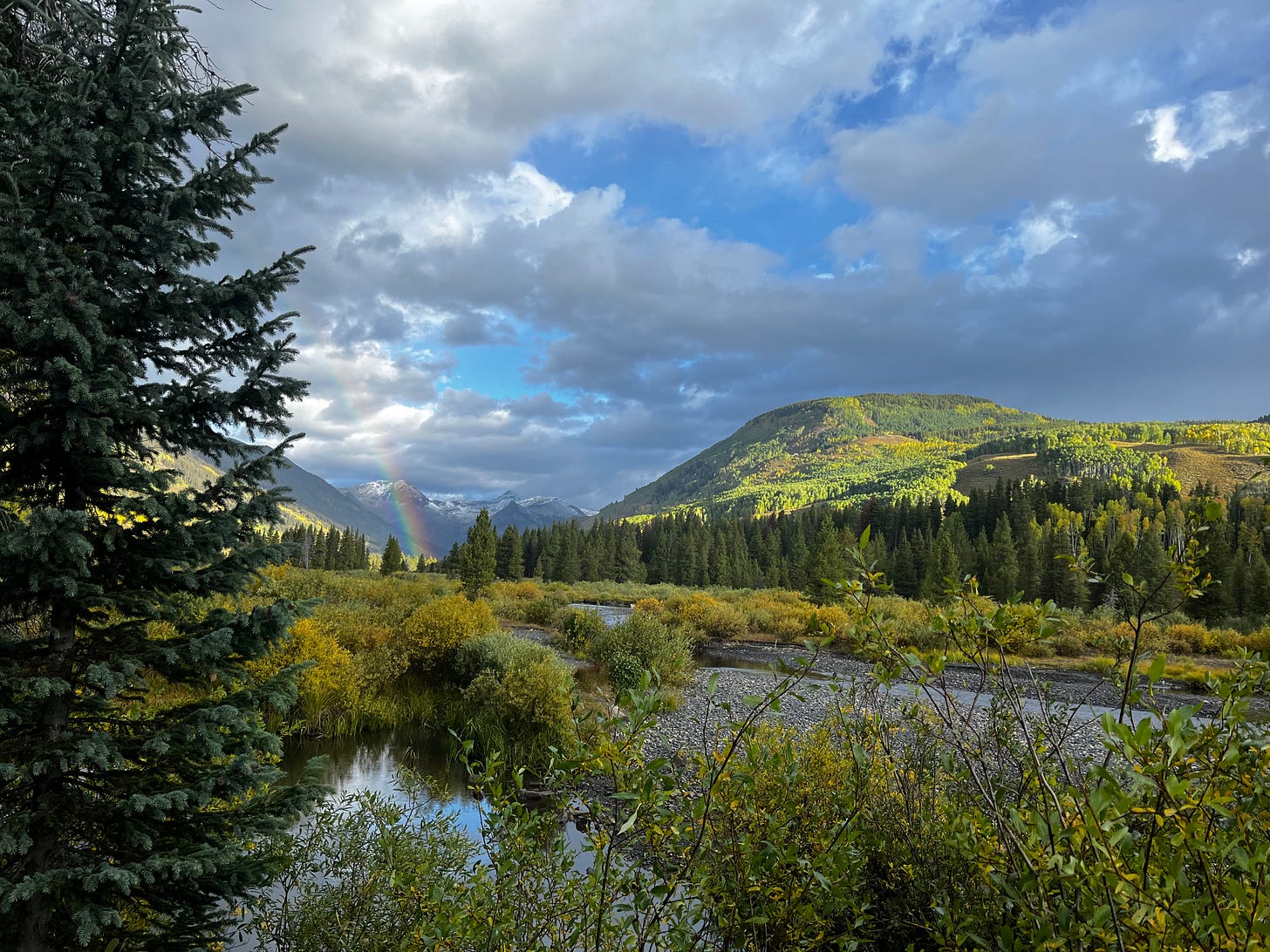New Fence Lines: Where Ranching Meets Recreation
Digital agritourism marketplaces and virtual fencing are shaping how humans interact with the land.
Recreation on a Regenerative Ranch
“Have you done anything like this before?”
The woman standing next to me asked me with a big smile on her face. We were in the queue at the start line of a gravel bike race in Debeque, Colorado.
I had participated in gravel races before, but this was the first time I’d attended a race that was hosted on a working ranch. The ranch was in a beautiful, remote location on the Western slope of the Colorado Rockies. As the hundreds of participating riders took off at the starting line, we descended through a pristine high desert landscape, riding over cattle guards and circling through the nearby town. The ascent took us back up through public land, where campers were making their morning coffee.
Soon, we encountered groups of cattle, sometimes in the middle of the road. Biking by these beautiful and quietly curious animals was a humbling experience that always warranted a photo opportunity.
Towards the end of the race, a storm began moving in across the vast landscape. The dark clouds were generating bolts of lightning 50 miles away and a breeze had kicked up. Rain started to sprinkle down, providing cooling relief. We were 10 miles from the ranch headquarters and fortunately the way ahead was entirely downhill. As we sped down the gravel road, we passed dozens of cows who were gathering under trees and laying down in preparation for the storm. With their intermittent “moo’s”, I imagined they were laughing with one another about these crazy two-legged, two-wheeled animals flying down the road towards the incoming storm clouds.
As one of those crazy two-legged, two-wheeled creatures, I thought to myself: “If this gets really bad, will the cows take me in until the storm passes?” Fortunately (or unfortunately, depending on how you see it), I never got that experience as we were able to make it back to HQ ahead of the worst of the storm. But I think the cows would’ve allowed it, don’t you?
Today, let’s talk about agritourism and the technologies enabling farms and ranches to open up their beautiful land to recreational visitors.
Agritourism in Action
What if farms and ranches became celebrated hubs of community and education? Places where people learned about the environment and its ecosystems? Farmers and ranchers could earn a new stream of income from these activities, and non-farming people could develop a healthier, more nuanced understanding of how food, fuel and fiber are produced.
This is the promise of agritourism. According to the 2017 Census of Agriculture, nearly 28,500 producers (1.4% of all farmers or ranchers) participate in agritourism avenues on their farm or ranch in the United States. These activities have resulted in $950 million in sales. Agritourism activities can generate farm income through event-related admission fees, and they can also enhance direct-to-consumer sales opportunities of farm goods.
Another way to think about agritourism is as a public service. With 80% of the U.S. population living in urban areas, the vast majority of people have no direct reference point for rural landscapes, agricultural production or animal husbandry. That means that when they are voting or choosing which produce to buy, these citizens aren’t thinking of the farm or rural landscape. By encouraging agritourism, farms and ranches are participating in a cycle of public awareness and empowerment that can ultimately bring us all closer to the land.
Sourcing Adventures on Digital Agritourism Marketplaces
How do farmers spread the word about agritourism opportunities? Typically, they utilize everything from roadside signs to notices on farm websites and word of mouth. In recent years, they’ve had other avenues available to them: digital agritourism marketplaces. Similar to Airbnb for homeowners, digital agritourism marketplaces have emerged to allow farmers and ranchers to list their properties for farm stays or recreational activities.
For those who long to retreat to a farm for a few nights, Farmstay and Hipcamp provide a listing of on-farm lodging or camping sites that you can rent. Farmstay also advertises novel farm-related experiences like horseback riding or picking eggs from the coop. And with Hipcamp, campers can scope out the best sites for viewing solar eclipses or fall foliage. The site recently released a 2023 fall foliage map to ensure prospective campers snag sites under the changing leaves.
For wildlife, fishing and hunting enthusiasts, LandTrust is a site that advertises bird watching, hunting, fishing and farm tour experiences. LandTrust has sites all over the county, but focuses on the Great Plains region, listing over 1,000 different experiences across Montana, Nebraska and Kansas. Interested farms and ranches can earn up to $20,000 in increased income per year on the site.
These digital marketplaces are creating an ecosystem where working agricultural operations can diversify their income, and non-farming citizens can have novel, connected experiences on the land. What’s more, sites like LandTrust have a vested interest in supporting farms and ranches that use wildlife and biodiversity-friendly farming methods, as these methods fuel the hunting, fishing and bird watching opportunities advertised on the platform. With agritourism, we create a cycle that starts with diversified, regenerative production and results in people connecting with the land.
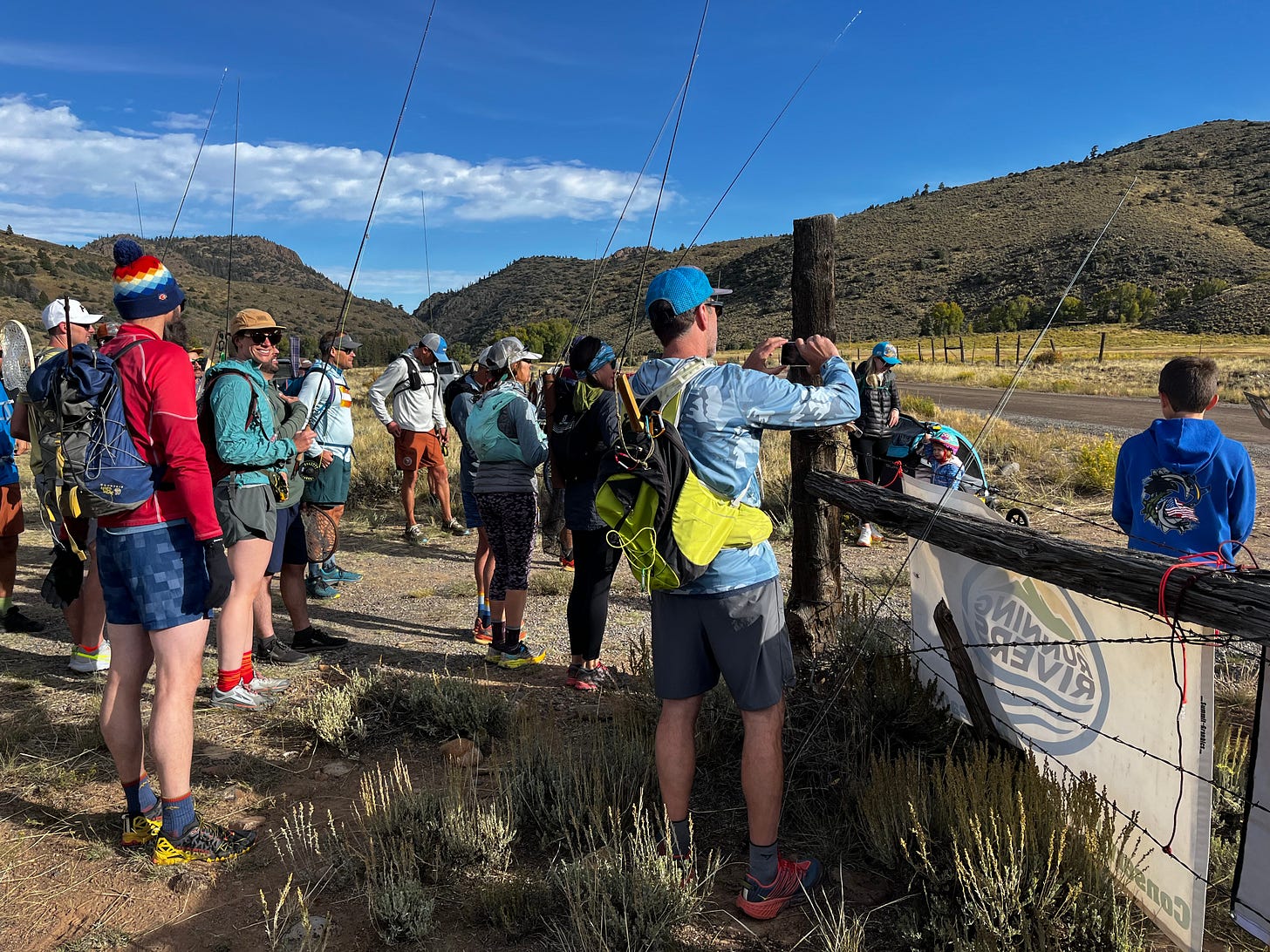
Virtual Fencing for Regeneration
Case in point: The ranch that hosted the gravel bike race from the introductory story is committed to regenerative ranching methods. I spoke with members of their ranching team, who were on-site selling beef cuts after the race, about how they’re doing this. They shared that they’re utilizing a new virtual fencing technology to manage their herd. The local Bureau of Land Management (BLM) is partnering with them to defray the costs of the technology for the next couple of seasons. In Colorado, BLM has been running experiments like this with ranches for several years now.
Fencing is critical for all ranchers, but when you’re raising your animals in regenerative systems, you need interior fencing that is highly mobile. You want your animals to move in a group quickly across the landscape so that they’re eating the plants in a growth-stimulating manner.
In the water-scarce rangelands of the west, ranchers face unique challenges. The land slope is variable and sometimes inaccessible by truck or ATV. Herd stocking density is lower than in other cattle-heavy regions due to low water availability.
Enter virtual fencing.
Vence, one company offering virtual fencing technology, leverages GPS data and user-friendly web and mobile applications to allow ranchers to draw virtual fence lines on the property. The ranch animals wear devices that track their movements. The devices then send audio and shock signals to the animals when they approach a boundary, causing a shift in behavior.
According to Vence, this technology allows ranchers to reduce costs by 30% while increasing animal headcount. The company also offers insights from artificial intelligence to embrace better grazing patterns. It’s currently only available to operations with 500-head of cattle or more, with cost likely being the limiting factor.
Will Vence completely eliminate fencing? It likely won’t solve the challenges of outlining property borders or deterring predators, but in the case of interior cross fencing, virtual fencing companies can solve a huge need, especially for producers transitioning over to more regeneratively managed systems.
Virtual fencing also represents a huge shift in a ranchers’ workflows. Imagine that instead of driving across your fields for hours a day, you sit at your desk with a cup of coffee and view your herd as tiny dots on a screen. Rather than physically moving them with your horse or ATV, you simply push a button to queue them to move remotely.
For everyone else, virtual fencing represents a shift in how we access land. First, by making regenerative ranching practices more lucrative, virtual fencing pairs well with the recreational agritourism opportunities featured on sites like LandTrust. Second, virtual fencing could dissolve physical barriers and open our lands to fosters more human-environment interaction.
In the United Kingdom, for example, right to roam allows people to walk across beautiful hills of pasture, regardless of whether the land is private. While fencing isn’t a huge barrier to this (that’s what gates are for), what kind of psychological shift will virtual fencing lead to? It might further enable farmers to open up their land to the public for recreation, especially in areas like the mountain west where cattle are grazing through some spectacular vistas. This is especially relevant for privately-held land where ranchers are receptive to earning extra income - and fostering greater awareness - through agritourism.
An open landscape
In this post, we’ve explored how opening land up to others can diversify farm income and increase public familiarity with agriculture. It’s possible that virtual fencing and digital agritourism marketplaces can help us continue to open up our agricultural landscapes to new opportunities. Whether those opportunities are regeneration or human connection, let’s make sure our physical and philosophical fences are flexible enough to allow humans to connect with the land in ways that are educational, memorable and lucrative for us all.
Contributors
Author: Sami Tellatin
Photos: Ben Daniels & Sami Tellatin
Editors: Your name could be here! See an issue? Send me a message at samitell@gmail.com.
This AgPunk article was written and edited by humans. We use our own photos and AI art generator tools, such as MidJourney and Dall-E, to provide art throughout the text.
AgPunk Playlist
For some positive punk vibes to accompany your AgPunk reading, check out our playlist on Spotify. In it are themes of liberation, positivity, revolution and pure punk spirit.




